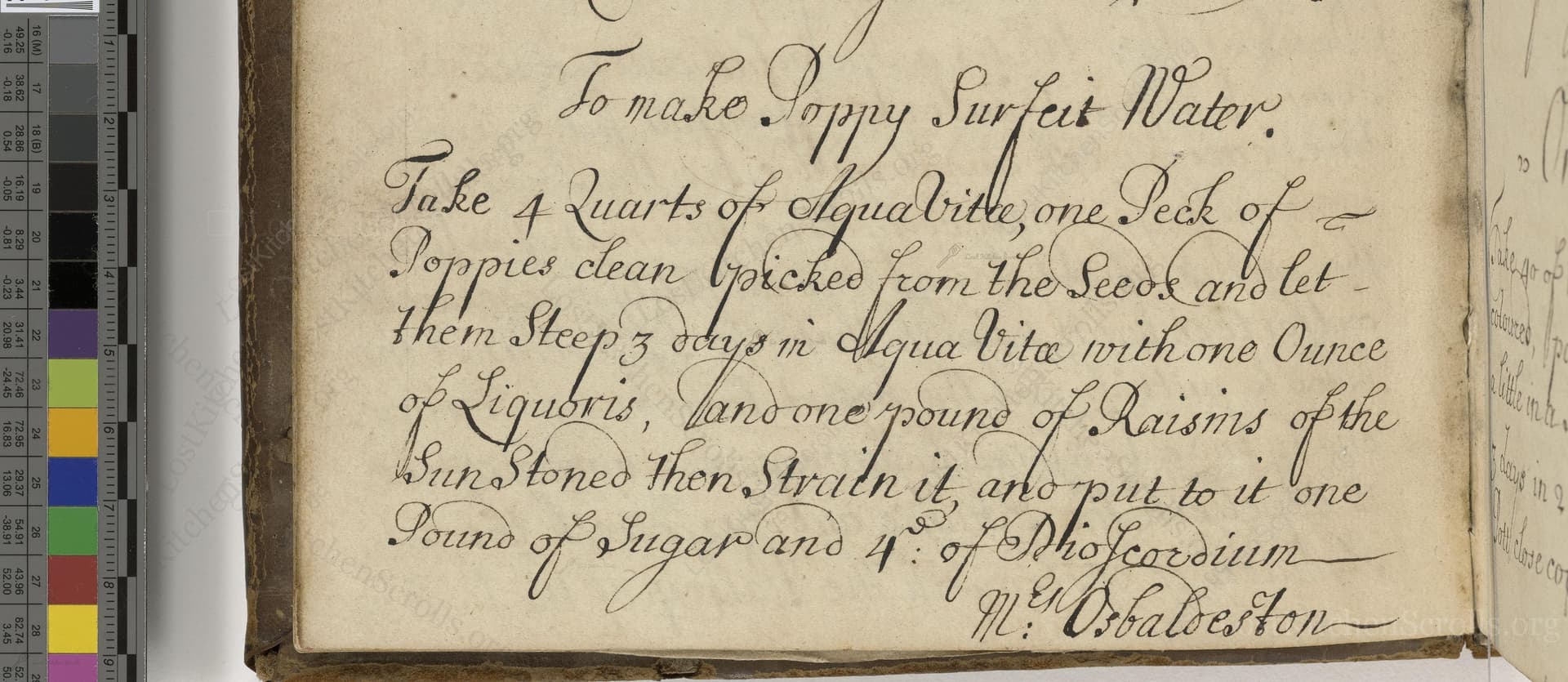To Make Poppy Surfiet Water
From the treasured pages of Cordial waters simple waters and syrrups
Unknown Author

To Make Poppy Surfiet Water
"Take 4 Quarts of Aqua Vita, one Peck of Poppies clean picked from the Seeds and let them Steep 3 days in Aqua Vita with one Ounce of Liquoris, and one poune of Raisins of the Sun Stoned then Strain it, and put to it one Pound of Sugar and 4. of Dioscordium M. Obaldeston"
Note on the Original Text
The recipe’s language reflects 17th-century English: quantities such as "Peck" (about 8 liters) and "pound" (roughly 454 grams) are used, with ingredients listed in the order of use but not strictly by modern step-by-step instructions. Spelling is non-standard by contemporary eyes ("Liquoris" for licorice, "Surfiet" for surfeit), and medical jargon like "Dioscordium" points to a blend of culinary and apothecary practices. Recipes like these expected cooks to have local knowledge and adjust on the fly, with plenty left unsaid for those in the know.

Title
Cordial waters simple waters and syrrups (1680)
You can also click the book image above to peruse the original tome
Writer
Unknown
Era
1680
Publisher
Unknown
Background
Step back to the kitchens of the 17th century with this delightful collection of time-honored recipes and culinary secrets, sure to enchant any lover of historical gastronomy.
Kindly made available by
Folger Shakespeare Library
This recipe comes from a 1680 English manuscript, a time when household remedy books were essential companions in middle and upper-class homes. "Surfeit water" was one of several herbal cordials brewed not only for enjoyment but for their perceived medicinal value, especially as gentle sleep aids or balms for overindulgence. The inclusion of poppy and Dioscordium—once a sweet medicinal paste with trace amounts of opiates and aromatics—speaks to both the period's taste for warming, aromatic drinks and a reliance on plant-based medicines in the home kitchen.

Back in the 17th century, this recipe would have been prepared using large earthenware or glass jugs for steeping, a wooden spoon for stirring, and fine linen or muslin cloth for straining. The resulting cordial would be decanted into bottles or flagons fitted with corks or wax seals. The preparation would have involved measuring by volume (quarts, pecks) and basic kitchen tools—no high-tech gadgets here, just patient hands and proper storage.
Prep Time
15 mins
Cook Time
0 mins
Servings
32
We've done our best to adapt this historical recipe for modern kitchens, but some details may still need refinement. We warmly welcome feedback from fellow cooks and culinary historians — your insights support the entire community!
Ingredients
- 1 gallon (4 quarts) strong clear spirit (e.g., vodka or unaged brandy)
- 2 gallons (approx. 1.75 pounds) fresh poppy petals, seeds removed (Papaver somniferum, note: fresh culinary flower petals without narcotic content can be subbed if necessary)
- 1 ounce dried licorice root
- 1 pound seedless raisins
- 1 pound granulated white sugar
- 14 ounces herbal honey syrup (substitute for Dioscordium; see above)
Instructions
- To make Poppy Surfeit Water, combine 1 gallon (4 quarts) of a strong clear spirit (such as vodka or unaged brandy, about 40% alcohol by volume) with 2 gallons (about 2 heaping grocery store bags) of fresh poppy petals, not including the seeds.
- Add 1 ounce (about 4 tablespoons) of dried licorice root and 1 pound (about 2 cups) of seedless raisins, which should be roughly chopped to enhance infusion.
- Let these macerate in the spirit for three days in a large, sealed glass container.
- After three days, strain the mixture thoroughly through a fine sieve or cheesecloth.
- Stir in 1 pound (about 2 cups) of white granulated sugar.
- For the 'Dioscordium'—a historical medicinal electuary that’s no longer widely available—use 14 ounces (about 1 2/3 cups) of a gentle herbal honey syrup containing opiate-free botanicals like valerian, hyssop, or violets to mimic the flavor (if possible).
- Bottle and let mature for at least a few days before serving as a cordial or medicinal tonic.
Estimated Calories
170 per serving
Cooking Estimates
It takes about 15 minutes to prepare the ingredients. The mixture needs to rest for three days, but there is no heating or actual cooking involved. Each serving is estimated to contain about 170 calories, mostly from the alcohol, sugar, raisins, and honey. The recipe makes about 32 servings (125 ml each from 4 liters of finished cordial).
As noted above, we have made our best effort to translate and adapt this historical recipe for modern kitchens, taking into account ingredients nowadays, cooking techniques, measurements, and so on. However, historical recipes often contain assumptions that require interpretation.
We'd love for anyone to help improve these adaptations. Community contributions are highly welcome. If you have suggestions, corrections, or cooking tips based on your experience with this recipe, please share them below.
Join the Discussion
Rate This Recipe
Dietary Preference
Culinary Technique
Occasions

Den Bockfisch In Einer Fleisch Suppen Zu Kochen
This recipe hails from a German manuscript cookbook compiled in 1696, a time whe...

Die Grieß Nudlen Zumachen
This recipe comes from a rather mysterious manuscript cookbook, penned anonymous...

Ein Boudain
This recipe comes from an anonymous German-language manuscript cookbook from 169...

Ein Gesaltzen Citroni
This recipe, dating from 1696, comes from an extensive anonymous German cookbook...
Browse our complete collection of time-honored recipes



